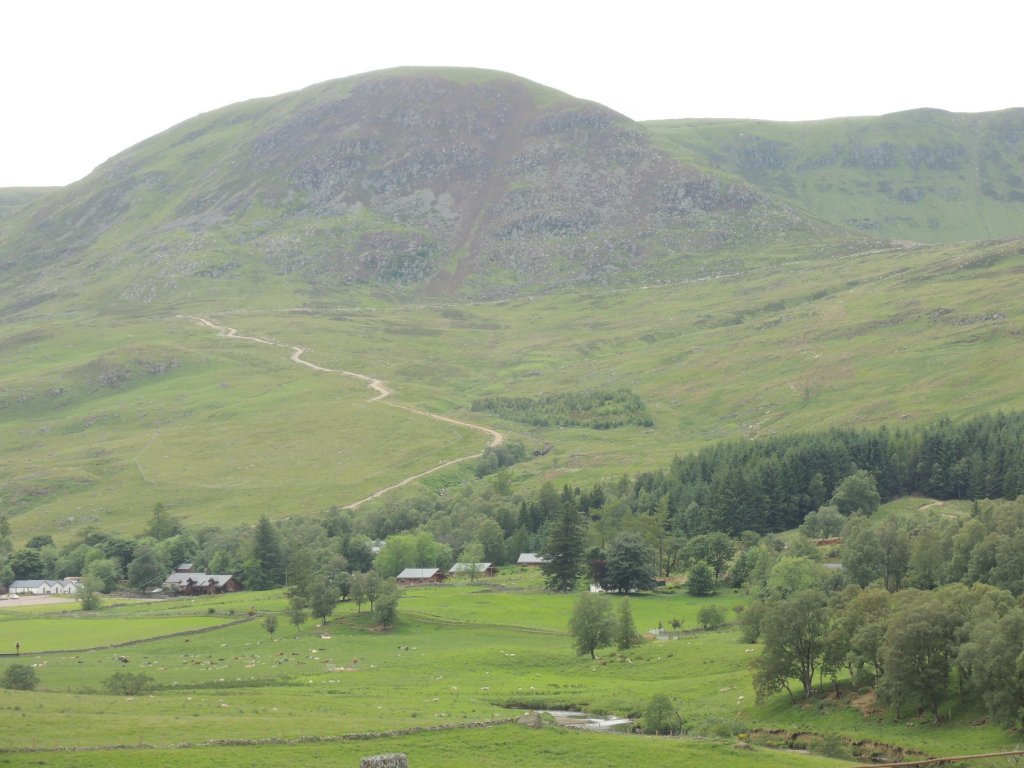
Glen Clova Hydro Construction Track
A week before taking action against the Cluny Estate track (see here) the Cairngorms National Park Authority issued a planning contravention notice against the owners of the Glen Clova estate for failing to remove the temporary hydro construction track behind the hotel. This is another very significant action from the CNPA and should be welcomed by all who care about the landscape. First, because the CNPA approved the hydro scheme on the basis that the track should be temporary – its permanent access tracks which cause the greatest landscape impact with hydro schemes – so well done to the CNPA for putting the landscape before profit. Second, because the CNPA are now prepared to enforce the conditions of the original planning application, unlike the Loch Lomond and Trossachs National Park Authority who caved in to the Glen Falloch Estate when they applied to make the temporary construction tracks there permanent (see here).
My thanks to Jojo Neff, who has been monitoring hill tracks and passed on some photos (above). Dismayed by what these showed, on Saturday I took the opportunity to have a look myself as part of a run round the Glen Prosen watershed. In the course of that I came across another temporary hydro track at the head of Glen Prosen which has also not yet been re-instated.

The track is visible from many points along the 8km ridge between Coremachy and Driesh. I was too far away – and without binoculars – to be able to tell if the horizontal scar across the hillside is still a track (would welcome information on this) or has been re-instated but to a very poor standard. The uphill section of the track is far more prominent than the lower part of the footpath to Loch Brandy.

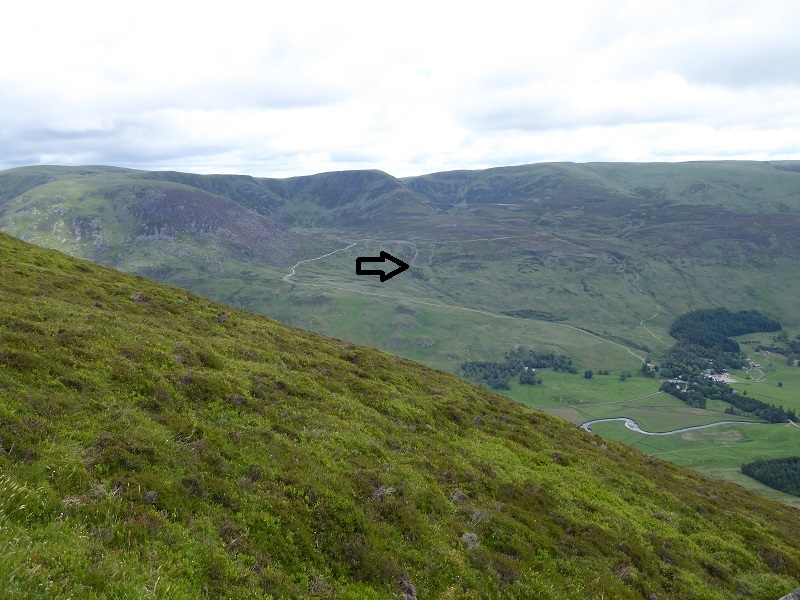
The planning application was approved by the CNPA planning committee in 2010. There is no information on the CNPA planning portal at present following the decision letter. As a result there is almost no information about the construction track. All I could find was a reference to “temporary access tracks” in the Committee Report and this map which shows the pipeline, not a track, and indicates therefore there was no proposal for a permanent track:
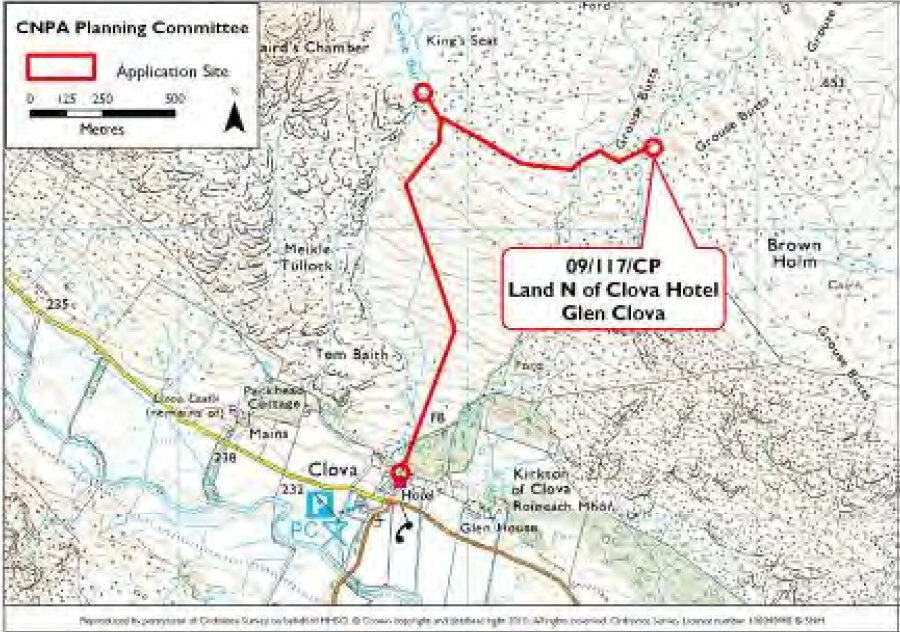
The Decision Letter from the CNPA required the developer to produce a Construction Method Statement, which would have provided information about where the temporary access track was to be sited and how it was to be constructed and the ground then re-instated, but this information is not public. Nor is there any information on the planning portal about when the work started, when it was “completed” or subsequent correspondence between the CNPA and the Developer. I will ask for all this information under FOI but in my view the CNPA’s reasons for taking action should be public (and should not be limited to a one line entry on their Planning Enforcement Register). It would also be in the public interest to know just how long negotiations had been going on before the CNPA decided to take enforcement action.
The owner of the land and developer of the hydro scheme appears to be Hugh Niven, who runs the Glen Clova Hotel, the Glen Clova farm – which has been supplying Albert Bartlett with potatoes for over 25 years (see here) – and Pitlivie Farm, near Carnoustie in Angus. This according to information on the internet is the site of one of Scotland largest agricultural roof mounted PV installations. An interest in renewables then.
Mr Niven had a run in with Angus Council Planning in Glen Clova just before the Cairngorms National Park was created. In 2000 (see here) Angus Council initiated enforcement action against Mr Niven because he had created a new loch in the Glen without planning permission and there were sufficient safety concerns about the earthworks that the public road was closed for a time. Two years later Mr Niven applied for, and was granted, retrospective planning permission for the works (see here).
There are lessons for this for the CNPA. First, this is not the first occasion Hugh Niven has ignored planning law. In this he is not unusual – many landowners still see planning authorities as imposing unwelcome restrictions on their ability to manage land any way they wish. Second, back in 2000 it appears that Hugh Niven argued that what he had done was justifiable and the risk is that he will now do so again which will lead to years of wrangling. While the creation of a loch might have been acceptable on landscape grounds, the permanent retention of this track is not and the CNPA therefore needs to avoid drawn into negotiations about how this scar could be ameliorated and take a stand. This track needs to be removed and like the Cluny track, is therefore a fundamental test for the CNPA. They deserve the support of everyone who cares about the landscape in our National Parks.
As in the Cluny case, it appears that the developer does not lack resources: the latest accounts for Clova Estate Farm Ltd doesn’t show income (because they are abbreviated accounts – a fundamental issue in terms of business transparency) but does show the business has total net assets of £8,037,710. Hugh Niven therefore has the resources to pay for the re-instatement of the hydro construction track.
Glen Prosen hydro track
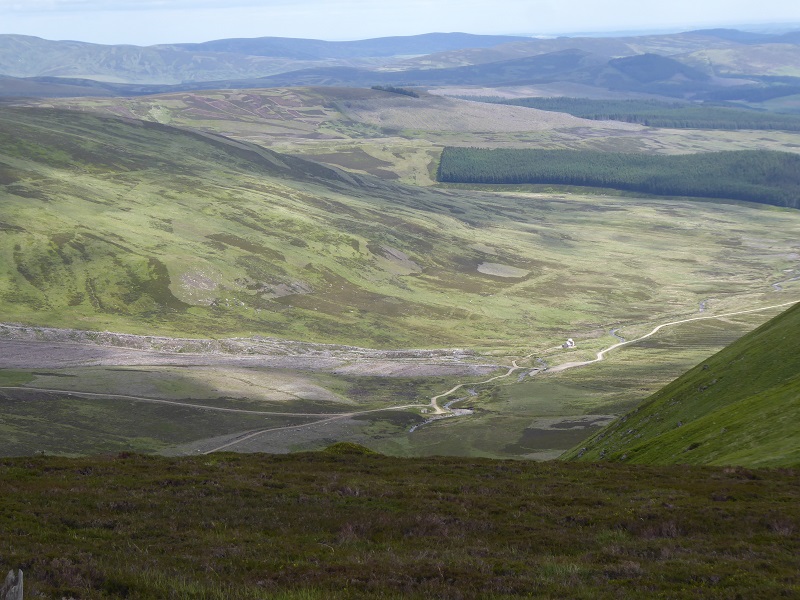
After completing the ridge on the west side of Glen Clova to Mayar and after coming across a new bulldozed track on the plateau leading from Bawhelps to Dun Hillocks (which I will cover in another post) the head of Glen Prosen is scarred by new tracks and clearfell north west of Kilbo.
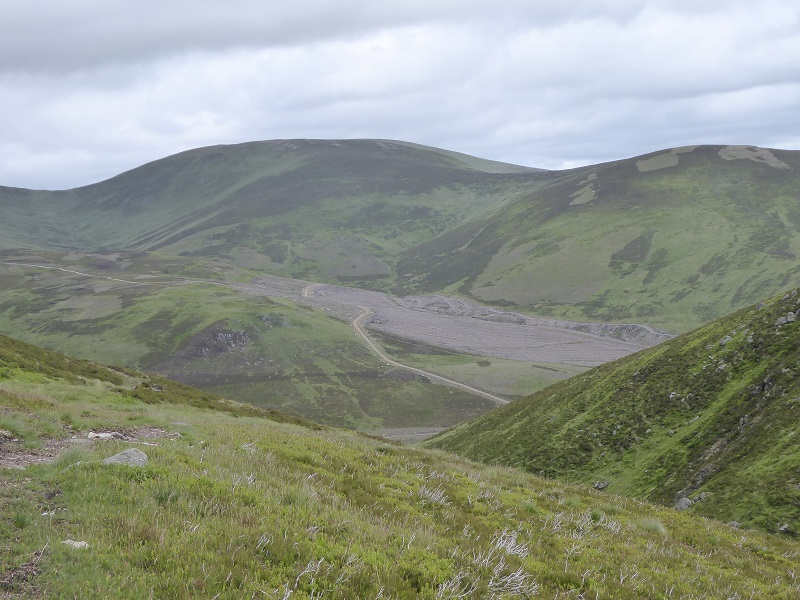
On returning home I checked the planning report from 2013 which made clear that the construction tracks would be temporary: “Beyond the powerhouse there will be a temporary access road for construction to reach both intakes.” Again well done to the CNPA for putting landscape before profit.
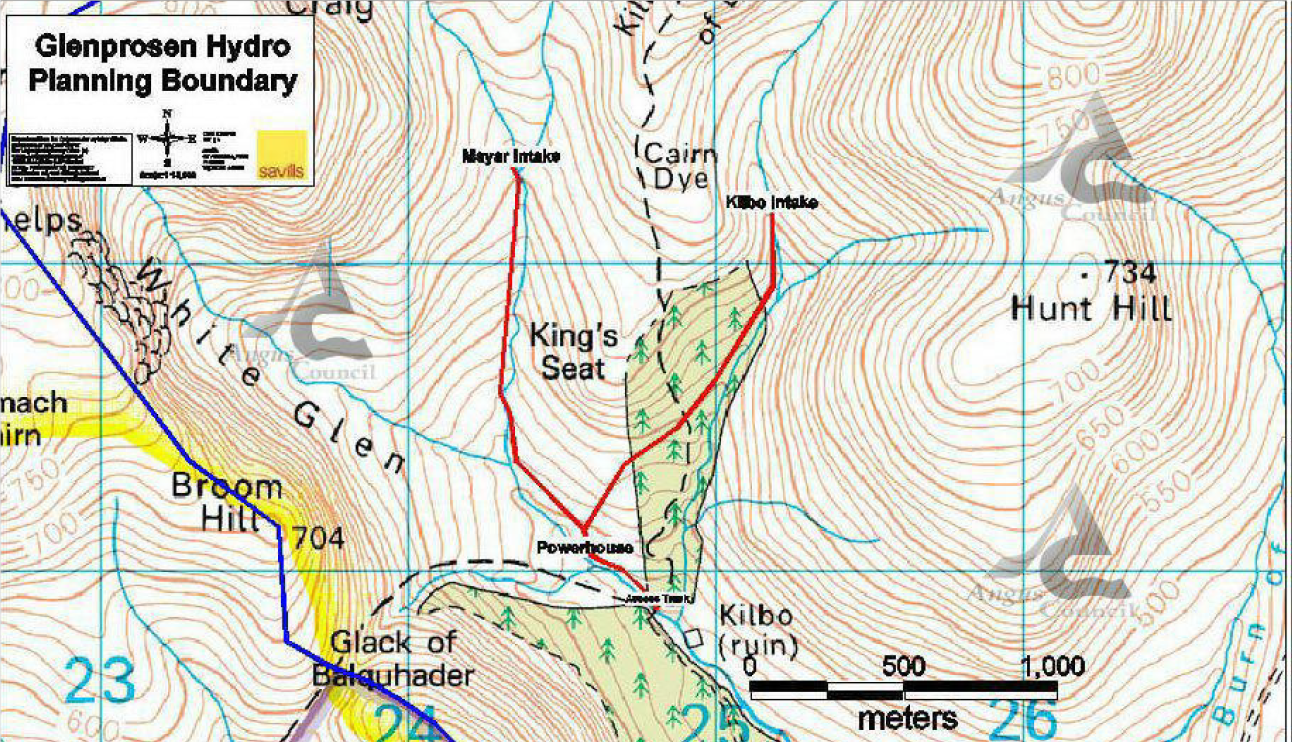
The Committee Report also concluded:
Landscape and Visual Effects
40. The landscape impacts of this proposal are minor, given the scale of the development and the location in the upper Glen Prosen. Conditions relating to the construction phase of the development have been proposed to minimise any short term impact. In addition, the set of mitigation measures proposed are likely to have a positive impact on the development site in the long term.
The trouble is at present the landscape impact is anything but minor, as the photos show, and this is mainly because the construction tracks have not been removed, although the clearfell has added to the destruction. There were no signs of machinery on site and it appears therefore that the Glen Prosen estate, like the Glen Clova estate, thinks the work is finished and simply hopes to avoid the expense of re-instating these tracks. It will be much easier for the CNPA to take action if they show resolution in addressing the Glen Clova track. The message to landowners will be then loud and clear: you cannot afford to ignoring the planning rules in the National Park.

This continuing degradation of our finest landscapes is primarily due to the failure of successive SNP governments to bring in full planning control over hill tracks. They have been repeatedly warned of the impact of these tracks since coming to power in 2007, yes 10 years ago, but have simply introduced “prior notification”, a useless measure which landowners can ignore. There is an urgent need, if the SNP is really committed to a “radical” land reform agenda, to legislate for full planning control and, where this is breached, to see enforcement action taken to close down tracks, restore the ground and suspend all public funding support for agriculture and forestry activities until restoration is complete.
I have known Glen Clova for the best part of 65 years and I am appalled that an outsider has the authority to despoil one of Scotland’s most beautiful glens.
Apparently Niven live done southe somewhere, so here we have another ‘foreigner’ who treats Scotland as if it were a playground for the ‘filthy’ rich! Hoe on earth did he get permission to build a loch.
The Scottish Government has a lot of questions to answer
Ian Sharpe. I don’t know how well you know Glen Clova but I think you will find that Mr Niven is a local and has been in the Glen for around 62 years since his birth and his ancestors before home owned the estate.
John Toshak, I stand corrected and admit to over-reacting to the article above. I know the Glen well enough to be able to comment on how the land can be spoilt very easily. ( My Great Grandfather, William Carnegie, who lived in Cortachy, was the Head Gamekeeper to the Earl of Airlie last century and I wonder what he would have thought about ‘scarring’ the landscape!) I don’t understand why Niven got permission to make a dam in the first place!
Ian Sharpe. Mr Niven has not been given permission to build a dam. A dam has never been constructed. Two intake pipes have been taken from Loch Brandy and are buried underground to the Turbine House at the rear of Clova Hotel. No visible items of the Hydro Scheme are on show to the general public. If there was no Hydro Scheme in place there would be no Clova Hotel or Lodges which is the main source of income in the Glen. The Hydro scheme is at the end of the day what will make the business a viable enterprise. I agree fully that the roads are not constructed to blend in with the scenery and a better method of construction should have been utilised. All the way travelling up the Glen from Cortachy these new roads are visible especially on Rottal Estate heading up to Loch Wharral. Perhaps Mr Niven is being victimised as his Estate is within the boundaries of the Cairngorm National Park.
John, I agree the land above the hydro pipes has recovered well but other things here are not quite right: the intakes are not on Loch Brandy, they are on the burns below, and although small, are visible and when I went two years ago were more so because of the failure to clear up assorted detritus around them; the Clova hotel existed before the hydro so its clearly questionable to claim there would be no hotel without them; and on the roads, the original planning permission did not include any permanent access tracks – the track appear to have been constructed afterwards though ATVs were driving from the top of the unlawful track to the first hydro intake when I last visited. To claim that Mr Niven is being victimised is I am afraid nonsense, it was Mr Niven or his agents who ignored the law and that was established at appeal which is why the track is meant to have been restored. Unfortunately, in Scotland landowners have got away with ignoring the law far too often but then, to compound matters, some claim they are being victimised when it is enforced.
A landowner should be exempt from planning laws to construct access tracks for safely accessing their farming land, as well as new fencing and waterway maintenance. Hydro schemes are an excellent clean, green renewable source of electricity in the Glen. Often planning authorities use nationally approved acts of law, often to the detriment of the economy. At the end of the day Scotland has to stand on it own two feet and the landowner is contributing to the GDP of the country. Keep up the good work!
Under the Prior Notification Scheme agricultural are exempt tracks are exempt from planning – and that is where the problem starts, landowners create tracks claiming they are for agricultural or forestry purposes when actually they are for sporting purposes.